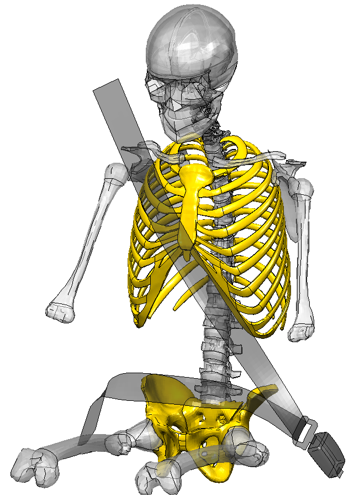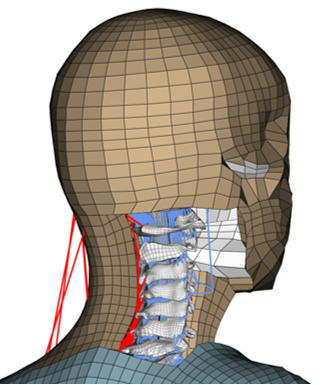NEW PROJECTS GRANTED FOR INCREASED INSIGHTS IN HUMAN MODELING – FOR SAFER MOBILITY
Researchers at SAFER’s partner institutions have recently been awarded grants from Vinnova/FFI for two studies on human modeling, which can be used in the development of vehicle safety systems.
The SAFER Human Body Model (HBM) provides a competence platform for our partners and serves as a natural contact point for external cooperation. This virtual human substitute can predict injury outcomes in any impact situation and direction of loading. It can be morphed to replicate a large portion of the population, standing or sitting, with human-like kinematics in crash events as well as pre-crash maneuvers. The SAFER HBM research integrates several projects, all aimed at advancing the existing model towards enhanced performance.
The traffic safety benefit is very clear in these two new projects: Improved torso and neck injury risk predictions for males and females contribute to the development of enhanced occupant protection systems, reducing fatality and injury risks for occupants in future vehicles. Both projects will continue until early 2027.

Project 1: Enhancing Female and Male SAFER HBM Torso Injury Prediction (I-HBM V)
As future vehicles are expected to accommodate a greater variation in occupant sitting postures and activities, ongoing development in occupant safety is essential to provide high levels of protection in future crashes. This project, involving partners Autoliv, Chalmers, and Volvo Cars, aims to further improve the torso injury risk prediction capabilities of the SAFER Human Body Model. Specific goals include updating chest modeling, enhancing rib fracture risk predictions, developing new capabilities for sternum and costal cartilage fractures, and improving pelvis fracture risk assessments. The project will also consider the effects of population variability, such as age, sex, size, and individual differences in injury risk developments.
Karl-Johan Larsson, Autoliv Research is leading this project, and the two PhD-students from Chalmers University, Erik Brynskog and Oscar Hallberg are working in the research team.
Project 2: Advancing Neck Injury Prediction in Car Crashes using the SAFER HBM
The cervical spine (neck) is a complex body region vulnerable to a variety of injuries, ranging from high severity (e.g., fractures and dislocations) to more frequent lower severity soft-tissue injuries, often referred to as whiplash. With increasing vehicle automation, occupant positions and activities are expected to vary more, facilitated by a broader range of seating positions and automated pre-crash interventions. This project focuses on developing an advanced cervical spine model and associated injury prediction capabilities for the SAFER HBM, enabling the analysis of future crash scenarios for a diverse population of occupants. Partners in this project are Autoliv Research, Chalmers M2 Vehicle Safety Division, Folksam and Volvo Cars. Jonas Östh is leading the team, and there is one PhD student from Chalmers University involved; Yash Niranjan Poojary.
Several previous studies
These projects build on several previous studies, including “Development of Implementable, Omni-Directional Chest and Spine Injury Criteria for HBMs (IHBM III),” “Assessment of Passenger Safety in Future Cars,” “Taking SAFER HBM to the Global Arena; Focusing on the Cervical and Thoracic Spine.” “Global SAFER HBM”, “HBM Shoulder” and “Car Passenger Safety - To the Next Level”.

